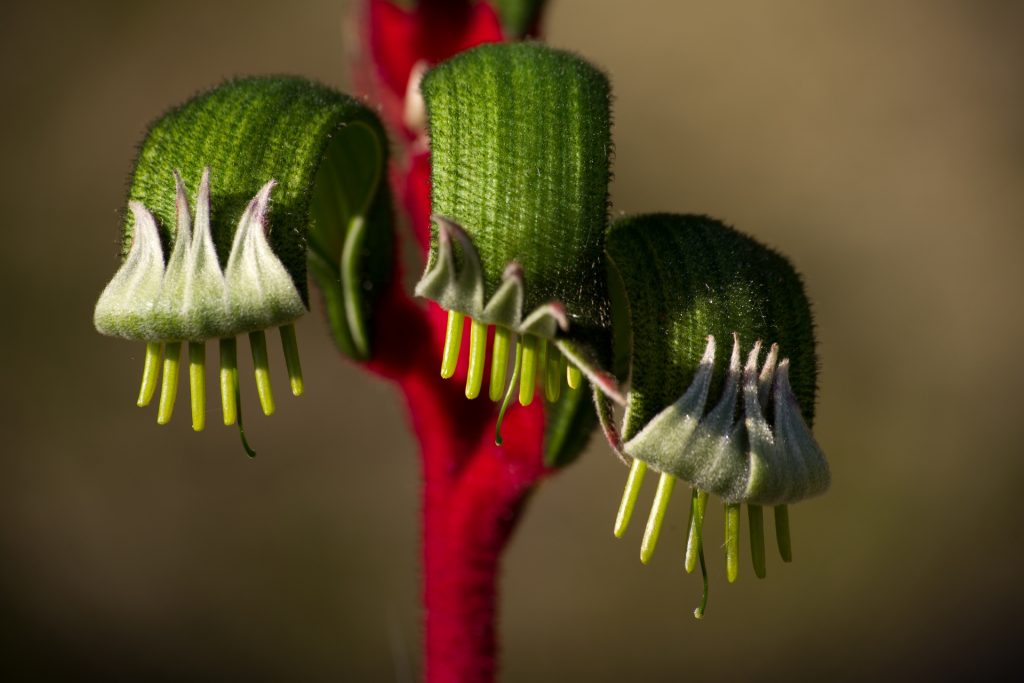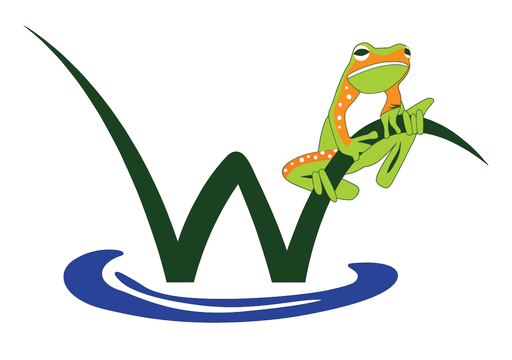The iconic Kangaroo Paw with its vivacious, bright and almost iridescent flower shines through the native foliage. It is a lively presence here where much else is muted.
The Kangaroo Paw calls Western Australia home and is endemic to this region. Find it growing wild along roadsides, in eucalypt forests, along river banks, around swamps and shallow waters…nearly anywhere it can take root. Since it requires well-drained soils and plenty of sunlight, that is nearly everywhere in this arid and sunny state.
Different species flower in different months from July to December. And, it is responsible for creating a colourful and pleasing display along with other bright and cheery wildflowers that add their own signature hues to the scheme.
Its remarkable features – the velvety stem and flower, the vibrant colours and the unusual paw-like flower head – make it popular and highly desired in gardens across the world. And, it is an export favourite being frequently shipped to the USA, Japan and Israel.
The unique red-green flowers are alluring. But a stunning palette of pink, yellow, orange and green is also available. And, Kangaroo Paw is perfect for both fresh and dried flower arrangements.
It stands as a testament to our dynamic yet delicate environment. Perhaps this is why it is chosen as a floral emblem for our state of Western Australia, and it even appears on many stamp issues.
This isn’t nearly enough. There is more to this amazing native flower.
Did you know that there are 11 species and 13 recognised sub-species of Kangaroo Paw, with one species holding a genus all to itself? Did you know that Kangaroo Paw is pollinated by birds and can encourage native bird activity in your garden? Or, how about the fact that this dazzling, beautiful flower is resilient, strong and hardy beyond imagination.
Read on as we rediscover a gem and discuss its fascinating aspects.
A bit of history
Jacques-Julien Houtou de La Billardière, naturalist and botanist, was responsible for first describing Kangaroo Paw in 1792. He made the observation when the ship he was aboard, “d’Entrecasteaux’s ship Espérance”, made a stop for repairs in Esperance during its expedition to Australia.
 His collections contained more than 4000 plants, of which three-quarters were previously unknown. And, valuable descriptions of the lands and peoples that the expedition visited, including detailed accounts of the ways of the Aboriginal peoples.
His collections contained more than 4000 plants, of which three-quarters were previously unknown. And, valuable descriptions of the lands and peoples that the expedition visited, including detailed accounts of the ways of the Aboriginal peoples.
The Kangaroo Paw blooms are fan-like clusters attached to long stems. Each flower has a bright red ovary and unusual paw-shaped petals. Seeing this he named it Anigozanthos rufus.
Anigozanthos – from the Greek anises, meaning unequal, and anthos, meaning flower, referring to the unequal perianth lobes of the flower. An allusion to the division of the flower into six unequal parts.
Some lesser known facts
Other than the Red and Green Kangaroo Paw a few other species are common. These include the Green Kangaroo Paw, which comes in a range of colours – from lemon yellow to emerald green, and Catspaw, which has smaller brightly coloured flowers.
The Aboriginal people call Kangaroo Paw Nollamara or Kurulbrang or Yonga Marra in the local Nyoongar language. They use it in preparing traditional medicine and the plant is of considerable significance to them.
Here are other incredible facts:
- The Red and Green Kangaroo Paw is the floral emblem of Western Australia since 1960.
- Flowers have no fragrance. And the furry flower and stalk can irritate skin and eyes on constant contact.
- Kangaroo Paws are pollinated by a variety of native birds, including honeyeaters and wattlebirds.
- The stalk of the plant is sturdy enough to perch birds that are attracted to its bright colours. The shape and position of the pollen-bearing anthers enable pollen to deposit on the perching birds.
- For feeding birds – As the bird pushes its beak into the tubular perianth to feed on the nectar, it brushes its head against the stamens which deposit pollen. Pollen is then transferred from flower to flower as the birds fly about.
- Kangaroo Paw forms a rhizome or modified stem underground. The rhizome grows to about 5cms in diameter and is responsible for making the plant resistant to fire and drought. The plant can often survive harsh conditions and re-sprout when circumstances change to become favourable again.
- Kangaroo Paws have tuberous roots which contain significant amounts of stored starch. These roots are eaten by Nyoongar people, similar to the way some orchids and lily species are too. Root tubers formed an important part of the traditional Nyoongar diet, and for this reason, it is possible that the roots of Kangaroo Paws were collected and gathered in large quantities.
- The Red and Green Kangaroo Paw only occurs naturally in southwest Western Australia. Found commonly around Shark Bay to Scott’s River and at Mt. Barker – Manjimup, along the Murchison River, Busselton, Lake Muir, and King’s Park near Perth.

Kangaroo Paws at The Wetlands Centre
If you are considering planting a native garden, Kangaroo Paw is indispensable. You can start by planting at least a few varieties in your garden for that dazzling effect.
If you come down and take a stroll in the perimeter of Bibra Lake or North Lake you will find the familiar sight that is the Red and Green Kangaroo Paw. You will find them blossoming in our waterwise garden too. They thrive rather well in their natural environ here. And our team of staff and volunteers do a great job of caring for the native plant life in and around this area.
To learn more about our amazing native plants and animals, and to help us make sustained and continued efforts towards conserving and rehabilitating our wetlands, come join us at The Wetlands Centre.
We look forward to seeing you there!
References
Young, R. (2019). Paws for Thought – Wildflower Society of Western Australia. [online] Wildflowersocietywa.org.au. Available at: http://www.wildflowersocietywa.org.au/advice-and-tips/paws-for-thought/ [Accessed 1 Mar. 2019].
Kangaroo Paws – Anigozanthos – Australian Plant Information. (2019). Anbg.gov.au. Retrieved 3 March 2019, from https://www.anbg.gov.au/anigozanthos/
La Billardière, Jacques-Julien Houtou de (1755–1834), Australian Dictionary of Biography, National Centre of Biography, Australian National University. http://adb.anu.edu.au/biography/la-billardiere-jacques-julien-houtou-de-2316/text3007, published first in hardcopy 1967, accessed online 3 March 2019.
Kangaroo Paw Plants, Flowers – Care, Prune and Growers Guide (2018). (2019). Ozbreed Plants. Retrieved 4 March 2019, from https://www.ozbreed.com.au/velvet-kangaroo-paws/
Stewart, A. (2019). Growing Kangaroo Paws. [online] Gardeningwithangus.com.au. Available at: https://www.gardeningwithangus.com.au/growing-kangaroo-paws/ [Accessed 4 Mar. 2019].


That is very unique flower